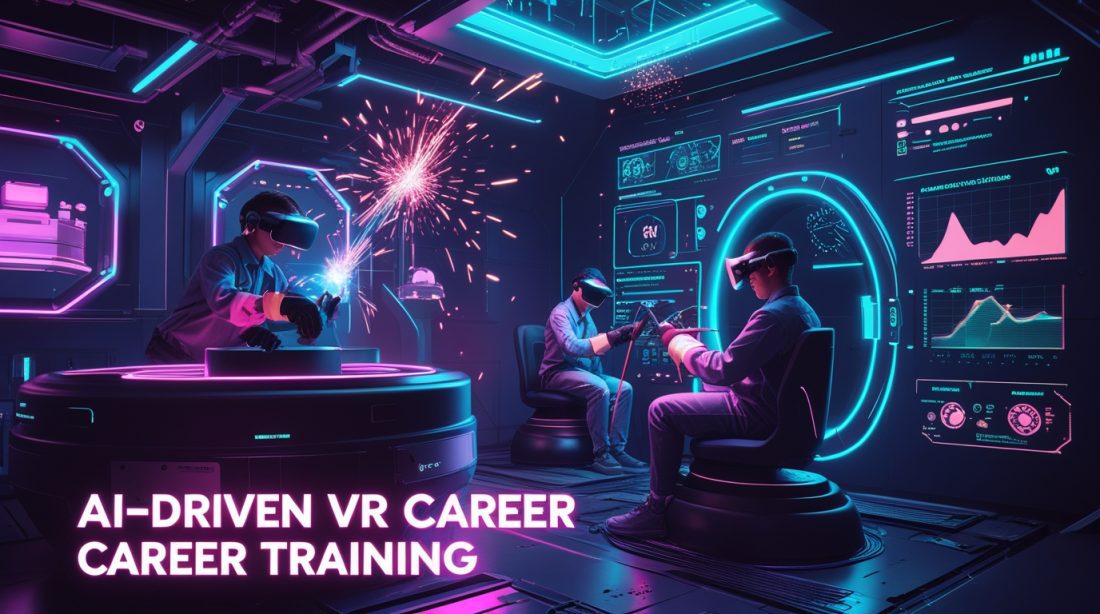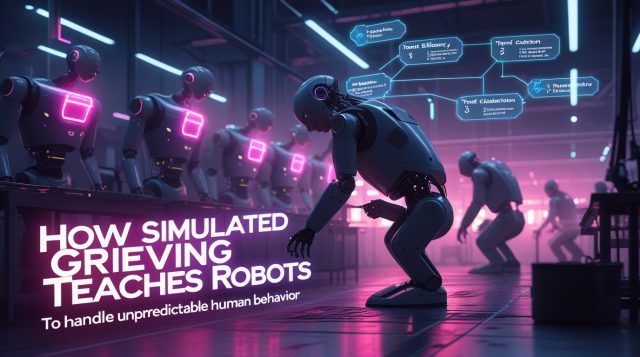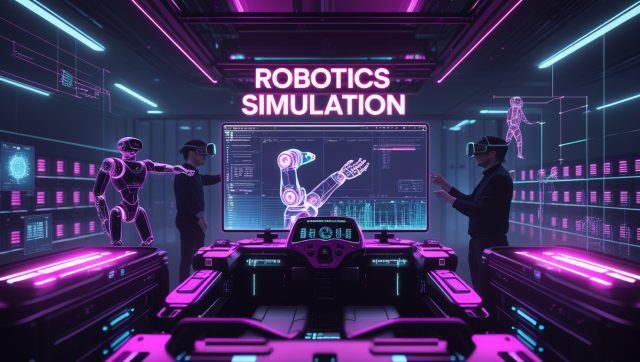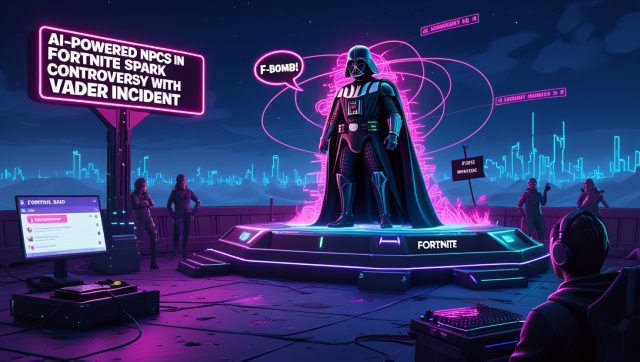Fast Facts
AI-driven VR career training programs, like virtual welding and 3D printing, are transforming vocational education. These tools provide safe, scalable, and data-rich learning environments that prepare a future-ready workforce. For industry, this shift means a new pipeline of skilled workers trained with unprecedented efficiency and analytical insight. This article explores the ‘why’ behind this industrial transformation, moving beyond the technology to examine the data-driven imperative reshaping how we build talent.
The narrative around vocational education is shifting. The question is no longer just if we should train students for skilled trades, but how we can prepare them for an industrial landscape increasingly defined by AI and data. The emergence of AI-driven VR career training in schools, particularly for high-stakes fields like welding and 3D printing, is a direct response to this challenge. This isn’t about replacing traditional learning; it’s about augmenting it with a layer of intelligence that accelerates skill acquisition, ensures quality, and builds a robust, data-verified talent pipeline for the industries of tomorrow.
Why AI and VR are Reimagining the Industrial Classroom
The traditional model of hands-on training, while invaluable, faces inherent limitations of scale, cost, and safety. Mastering a skill like welding requires hundreds of hours of practice, consuming expensive materials and posing safety risks. Similarly, learning 3D printing involves iterative prototyping, which can be time-consuming and resource-intensive.
AI-driven VR career training circumvents these bottlenecks by creating a risk-free, immersive digital twin of a real-world industrial environment. Here, students can practice, fail, and refine their techniques without real-world consequences. The critical differentiator is the integration of Artificial Intelligence, which moves beyond simple simulation to offer real-time, data-driven feedback on technique, precision, and efficiency. This transforms the learning loop from subjective observation to objective, quantifiable improvement.
A 2023 report highlighted that schools integrating VR laboratories saw a 35% surge in student engagement and a 28% increase in retention rates compared to conventional methods. This isn’t just about engagement; it’s about creating a more effective and data-optimized pathway to proficiency.
The Applications: Where Virtual Training Meets Real-World Demand
The convergence of VR and AI is proving particularly potent for specific technical skills. The table below contrasts its application in two critical fields:
A Deeper Dive into Virtual Welding
Programs like OcuWeld exemplify this approach. This VR welding simulator, designed by expert instructors, immerses students in a virtual lab where they can practice any weld position or process. The system provides real-time and post-lesson feedback on performance, allowing students to drill down into specific areas for improvement autonomously. It goes beyond the weld itself, requiring students to perform ancillary tasks like wire-brushing or adjusting machine voltage, mimicking a true-to-life workflow.
The industrial AI analysis here is clear: every student movement generates data. This data can be aggregated to identify common learning pitfalls, optimize the curriculum, and provide irrefutable evidence of a student’s readiness for a live workshop. As one industry developer noted, the goal is to “start bridging social classes and removing all of these barriers to education” by making high-fidelity training more accessible.
A Deeper Dive into 3D Printing and Design
In 3D printing, the challenge is often the gap between digital design and physical output. AI-driven VR training addresses this by allowing students to master the entire workflow—from 3D modeling in software like Fusion 360 to simulating the printing process—before ever loading a filament.
Emerging AI tools can now generate high-quality 3D models from text or images in seconds, democratizing the initial stages of design and allowing students to focus on refinement and practical application. Universities are already offering comprehensive specializations, such as the “3D Printing and Additive Manufacturing“ program from the University of Illinois, which teaches the end-to-end process from concept to printed object. The industrial benefit is a future workforce capable of designing for manufacturability from day one, reducing costly errors in professional settings.
The Data Dividend: How Training Intelligence Drives Industrial Intelligence
The most profound impact of AI-driven VR career training may lie in the data it generates. This is the core of the industrial ‘why’.
- Optimized Human Performance: AI analysis of training data can identify the precise techniques that lead to master-level work. This “golden batch” of human performance can then be used to train every other student, elevating the entire cohort’s skill floor.
- Predictive Workforce Analytics: Educational institutions can provide industry partners with verified skill metrics for graduates. A company hiring a welder can receive data on their consistency, best-performing weld types, and learning agility, moving hiring beyond the resume to a competency-based model.
- Curriculum Evolution: Instead of a static syllabus, training programs can become living systems. If AI identifies that 70% of students struggle with a specific pipe weld, the curriculum can be instantly adapted to provide targeted modules, creating a continuously improving educational feedback loop.
A study from Stanford researchers found that participants who engaged more deeply with a VR simulation formed deeper cognitive associations and could “learn, recall, and retain” complex information better than those who did not . This cognitive benefit, combined with performance data, creates a powerful argument for the efficacy of this training model.
Overcoming Implementation Hurdles
Despite its potential, adoption faces challenges. The primary barrier is cost, with concerns that expensive technology could widen educational equity gaps. Success requires strategic investment and a commitment to aligning VR curriculum with core academic and industry standards, ensuring the tools are not just flashy gadgets but integral parts of career preparation.
FAQ: Your Questions on AI and VR in Career Training, Answered
How accurate is VR welding training compared to the real thing?
VR welding simulators like OcuWeld are designed by expert welders to replicate real-world scenarios with high fidelity. They use real-time feedback on angle, speed, and distance to build correct muscle memory. While not a 100% replacement for final live practice, they efficiently build foundational proficiency and safety awareness.
Can students really learn 3D printing without a physical printer?
Yes. VR and simulation software teach the critical front-end skills: 3D modeling, design for manufacturability, and slicing. Platforms like Coursera offer courses from top universities that cover this entire digital process. This ensures students understand the why behind a design before using costly materials, making the physical printing phase more efficient and successful.
What is the return on investment for schools implementing these programs?
The ROI is multi-faceted. It includes reduced material waste (metal, filaments), lower safety insurance costs, and the ability to train more students without expanding physical lab space. Furthermore, it positions the school as a leader in modern, effective career and technical education (CTE), attracting students and industry partnerships.
Are these skills actually in demand?
Absolutely. The U.S. Bureau of Labor Statistics forecasts that STEM occupations will grow by nearly 11% from 2021 to 2031, significantly faster than the average for all other jobs. Roles like welders, advanced manufacturing technicians, and 3D printing specialists are crucial to the industrial base.
Subscribe to Our Newsletter
Get the Latest Insights on Industrial AI
Stay ahead of the curve in the rapidly evolving world of smart manufacturing and workforce development. Subscribe to the CreedTec newsletter for exclusive analysis, case studies, and reports delivered to your inbox.
[Subscribe Now]
Further reading
- How Simulated Grieving Teaches Robots to Handle Unpredictable Human Behavior
- Robot Esports Competitive Training: How Sim Training Builds Dexterity & Speed
- Sim to Game to Real: The Hidden Shift in Robotics
- How Gaming Policy Boosts Industrial AI Training Simulations in 2025
- Robotics Simulation Now Replacing Physical Prototyping



